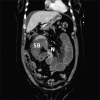Case of a strangulated right paraduodenal fossa hernia in a malrotated gut
- PMID: 28739567
- PMCID: PMC5623217
- DOI: 10.1136/bcr-2017-220645
Case of a strangulated right paraduodenal fossa hernia in a malrotated gut
Abstract
We report an unusual case of a strangulated internal hernia resulting from a right paraduodenal fossa hernia (PDH) in the context of bowel malrotation. There are few documented cases of PDHs associated with a concomitant gut malrotation. Emergency laparotomy was performed based on clinical and radiological. Intraoperatively, the proximal jejunum was seen to enter a hernia sac formed by an aberrant duodenojejunal flexure located to the right of the aorta. This was presumed to be a strangulated internal hernia of the paraduodenal recess in a malrotated gut. The hernia neck was widened and the sac obliterated to allow reduction of the contents. On reduction and warming, the insulted small bowel appeared viable and returned to the abdominal cavity without resection.
Keywords: gastroenterology; gastrointestinal system; stomach and duodenum.
© BMJ Publishing Group Ltd (unless otherwise stated in the text of the article) 2017. All rights reserved. No commercial use is permitted unless otherwise expressly granted.
Conflict of interest statement
Competing interests: None declared.
Figures



References
Publication types
MeSH terms
Supplementary concepts
LinkOut - more resources
Full Text Sources
Other Literature Sources
Medical
